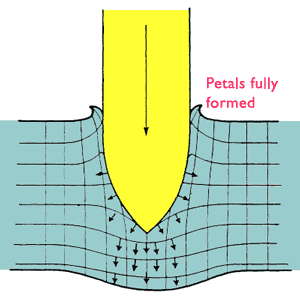
Logo from Scott Cunningham.

Logo from Scott Cunningham.
![]() he influence of the rear face will become important as soon as the thickness is less than about two calibres. Since full calibre kinetic energy projectiles are seldom employed against plate of more than two calibres in thickness, plates of normal thickness cannot be treated as though of infinite thickness at any stage of penetration. Once the projectile’s head is immersed in the plate, penetration will proceed, to some extent at least, by the formation of a bulge on the back surface of the plate.1
he influence of the rear face will become important as soon as the thickness is less than about two calibres. Since full calibre kinetic energy projectiles are seldom employed against plate of more than two calibres in thickness, plates of normal thickness cannot be treated as though of infinite thickness at any stage of penetration. Once the projectile’s head is immersed in the plate, penetration will proceed, to some extent at least, by the formation of a bulge on the back surface of the plate.1

Plate deformation associated with the formation of a back bulge. Diagram from 1.
It appears that this process is accompanied by some sideways displacement of plate material by the ogive, and that penetration proceeds by a combination of forwards and sideways displacement of material by the head of the projectile. It is to be expected, however, that as plate thickness is reduced, or as penetration proceeds, the tendency towards forward rather than sideways displacement of the plate material will increase.1
As penetration proceeds under these conditions the bulge on the back face becomes more pronounced and more sharply curved over the apex, while increasing shear strain develops over the cylindrical surface of the plug of metal ahead of the projectile. Under these conditions, the fracture of the plate will ultimately occur in one of two ways, depending upon the plate properties. Either a star crack will develop at the apex of the bulge due to the tensile stresses set up there, or a plug of roughly calibre diameter will shear out.1
 Star Crack and Back Petal Formation
Star Crack and Back Petal Formation
Do you like this web site? Please rate it between one and ten, with ten being the best:
Ratings are submitted to: The Wargames and Military History Search Engine.
Copyright © 2000 David Michael Honner. E-mail: GvA@wargamer.org.